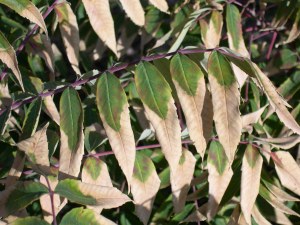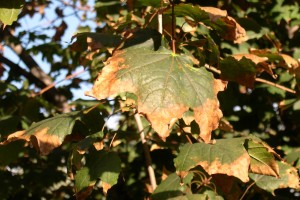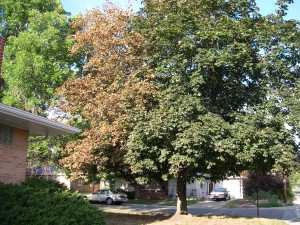Today’s post is a long one, but I’ve filled it with pretty pictures. 
Not many people would get up at 2 a.m. to drive a couple of hours to see sod cut, but hey, it’s summer and I didn’t have anything better to do. Barreling along in my pickup east of Greeley and headed to Fort Morgan, CO, Pink Floyd’s Learning to Fly added a touch of the surreal to an otherwise crazy trip.
You see, I wasn’t on my way to see just any sod lifted; this was the cutting for the Minnesota Twins’ brand new ballpark, Target Field. And though I’m a Rockies fan, I love baseball enough to want to see where the emerald carpets come from, here at Graff’s Turf Farms.
But it wasn’t easy. Graff’s grows plenty of sod for major league ballparks – they’re one of the four companies nationally who provide high quality sand-based turf. They’ve covered Coors Field, Invesco, Wrigley Field, Kauffman Stadium in Kansas City, and Busch Stadium in St. Louis. 
But it wasn’t until the Twins contracted them that Graff’s started having…visitors. Apparently Twins fans aren’t normal; they travel great distances to get a peek of their teams’ sod. Fearing that fans would try to yank a souvenir fistful, Graff’s hid that bluegrass the only way they knew how – in the middle of 440 acres of other lawn grass.
Getting a glimpse was near impossible until the day came – one year after seeding – to cut, roll, load and haul the turf to it’s new home in the frozen north. Any media members crazy and willing to come view this at 4 a.m. were welcome.
So there I was, crazy enough to go. And what I learned out there is this: it’s bloody dark at 4 o’clock in the morning. Bouncing over a few fields to get to “location X,” we were handed reflective vests to wear, because sod cutting is all about the accessories. 


Dr. Tony Koski, my friend the Colorado State University Turf Specialist, had trotted off into the darkness to follow the harvester and talk shop with the Twins’ bigwigs.
Dawn eventually arrived and by then I’d gotten to know the turf pretty well, having tripped and fallen face first onto it a few times. This didn’t matter to the other three media folks – they were having their own darkness-negotiating moments, one involving a calling card left by an animal.
As the sun crested the horizon it lit up one of the biggest trucks I’ve ever seen sitting mammoth-like, waiting for its load. Roll after roll of sod, 4-feet wide by 75-feet long and 2,200 pounds each (just over a ton!) was placed gently onto the trailer by forklifts. The huge machine pulled the rolls up the hill to refrigerated semi-trucks, pre-chilled to a perfect 40 degrees Fahrenheit. 
No ordinary trucking company was contracted to haul the dreams of Twins fans. To do that, Fortune Transportation (Windom, Minnesota) was selected, mainly because they carry the good things in life: beer, pizza, and ice cream. “We know they’ll keep their reefers on,” said James Graff, who owns the farm with Marty Thiel, “plus this company is willing to park 18 trucks in order to double up the driving crews.”
Doubling the driving teams was the only way to keep those 18 wheels rolling from Ft. Morgan straight through to Minneapolis, which they had to do without stopping, because the contract called for cut-to-laydown within 24 hours.
Those crazy Twins. 
But it happened: sod that left at 6 a.m. on the first truck – driven by Dave Bockelman and Dave Jorgensen (the 2007 Minnesota Truck Driver of the Year) – arrived at 10 p.m. that evening at Target Field.

 Because Minnesotans seem to like the dark, the turf was immediately unloaded and installed in the outfield along the 3rd base line. Portable lights flooded the field, allowing the sod installers to put down perfect seams. To protect the sand-based ground, donkey forklifts were brought from Graff’s for the job; they spread the weight of machine and sod out so it doesn’t form ruts in the soft surface.
Because Minnesotans seem to like the dark, the turf was immediately unloaded and installed in the outfield along the 3rd base line. Portable lights flooded the field, allowing the sod installers to put down perfect seams. To protect the sand-based ground, donkey forklifts were brought from Graff’s for the job; they spread the weight of machine and sod out so it doesn’t form ruts in the soft surface.
My buddy, Alison Stoven O’Connor, was there, helping to cover the event from the standpoint of a native. She’s crazy too. Her notes, sent at the unholy hour of 2:30 a.m. this morning, read:
“I entered the stadium through the basement or ground level. Then I snaked my way up to the first level and walked down to the seats on the 3rd base side. They were padded. Nice chairs.
The only thing lit up, aside from the portable lights on generators, was the Twins marquis.
The Twins beat the Orioles tonight, 2-1. A good omen.” 
Dave St. Peter, President of the Twins, spoke of the future of the field with Alison. “Year one will focus on getting the turf healthy and fair for play; in future years the field will be customized to the players. Over time, the field will be shaped. At the end of the day, we want a field that fielders feel good about.”
The Twins hired Larry DiVito as Head Groundskeeper, who oversaw the installation of the Washington Nationals stadium last year. To deal with glacial winter temperatures, DiVito will take this tender sod and coddle it this fall. Once temperatures chill and the grass goes dormant, he’ll tuck it in with specialty blankets; underground heaters will keep it, and the clay infield, from freezing. In spring, the warmed field will lift the sleeping grass out of dormancy for opening day on April 12.
Read Full Post »








 Because Minnesotans seem to like the dark, the turf was immediately unloaded and installed in the outfield along the 3rd base line. Portable lights flooded the field, allowing the sod installers to put down perfect seams. To protect the sand-based ground, donkey forklifts were brought from Graff’s for the job; they spread the weight of machine and sod out so it doesn’t form ruts in the soft surface.
Because Minnesotans seem to like the dark, the turf was immediately unloaded and installed in the outfield along the 3rd base line. Portable lights flooded the field, allowing the sod installers to put down perfect seams. To protect the sand-based ground, donkey forklifts were brought from Graff’s for the job; they spread the weight of machine and sod out so it doesn’t form ruts in the soft surface.

 Look for evenly discolored spots on leaves, typically from the tips inward but not always. The discolored area have no rings, halos or fruiting bodies – if you see any of those things, you should suspect fungus or bacteria.
Look for evenly discolored spots on leaves, typically from the tips inward but not always. The discolored area have no rings, halos or fruiting bodies – if you see any of those things, you should suspect fungus or bacteria. 







